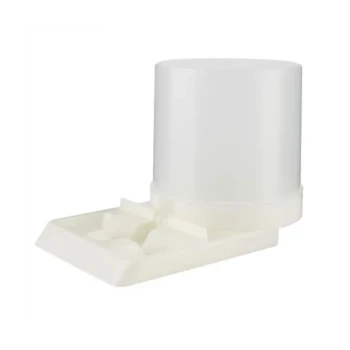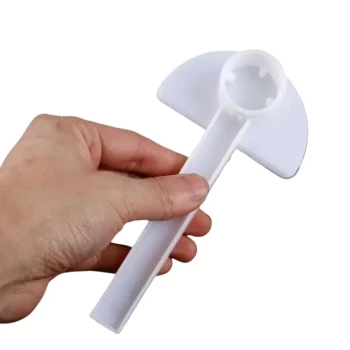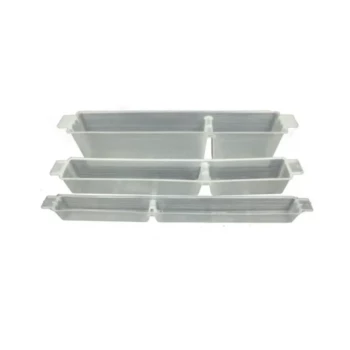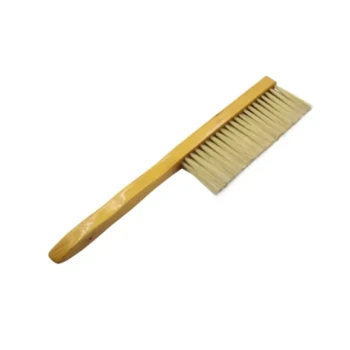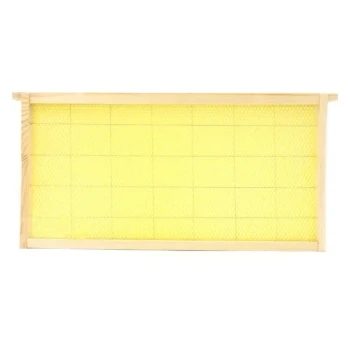The most effective method for feeding bees is slow feeding, which mimics a natural nectar flow without overwhelming the colony. This is best accomplished using a contact feeder (like a pail feeder), a smaller tray feeder, or a frame feeder placed inside the hive. Critically, feeding should only occur when necessary and never during a honey flow to avoid contaminating your honey harvest with sugar syrup.
Your goal is not simply to provide food, but to support the colony's health at critical times. The best feeding method is one that delivers clean energy safely, minimizes disturbance, and prevents robbing from other hives.

What to Feed Your Bees (And What to Avoid)
Before choosing a feeder, you must understand what fuel is safe for your bees. Using the wrong sugar source can cause significant harm to the colony.
The Gold Standard: Cane Sugar Syrup
The universally recommended food is a syrup made from pure white granulated cane sugar and water. Cane sugar is easily digestible and free from impurities that can cause dysentery in bees.
The ratio of sugar to water depends on your goal. A 1:1 ratio (by weight or volume) stimulates brood production, while a thicker 2:1 ratio (sugar to water) helps bees build up winter stores.
What You Must Never Feed Bees
Avoid all other sweeteners. High fructose corn syrup, beet sugar, and molasses contain compounds that can be toxic or cause digestive issues.
Never feed bees honey unless you are certain it came from your own disease-free hives. Honey from other sources can carry devastating diseases like American Foulbrood, which can wipe out your colony.
Choosing the Right Feeder Type
The feeder you choose impacts convenience, colony disturbance, and safety. Each style has a specific purpose and associated risks.
Top Feeders
These feeders sit on top of the hive body, directly under the main cover. They hold a large volume of syrup and are very easy to fill with minimal disturbance to the bees.
Because they are enclosed within the hive, they are one of the best options for preventing robbing by bees from other colonies.
Frame (or Division Board) Feeders
A frame feeder is a thin, hollow container shaped exactly like a frame. It takes the place of one of the frames inside the hive body.
This method keeps the food source contained, which also reduces robbing. However, it requires you to open the hive completely to check and refill the syrup.
Pail (or Contact) Feeders
A pail feeder is a container, often a simple bucket, with very small holes in the lid. It's inverted over the inner cover's hole, allowing bees to access syrup through the holes.
The vacuum pressure prevents the syrup from dripping, forcing bees to take it slowly. This design is excellent for simulating a slow nectar flow.
Entrance Feeders
These small feeders sit at the entrance of the hive. While simple and cheap, they are generally not recommended by experienced beekeepers.
Their placement at the hive entrance is a strong invitation for robbing by other bees and wasps, which can be devastating for a weak colony.
Understanding the Trade-offs and Risks
Responsible feeding is about more than just providing sugar; it's about managing the potential downsides to protect your colony.
The Danger of Robbing
A strong smell of sugar syrup can trigger a "robbing frenzy," where bees from stronger nearby hives attack a weaker one to steal its resources.
Always use feeders that minimize spills and are located inside the hive. Entrance feeders are the highest risk for inciting robbing.
Preventing Honey Adulteration
The single biggest rule of feeding is to never feed syrup when bees are producing honey you intend to harvest.
Bees will store sugar syrup in the comb just like nectar. If you feed during a honey flow, your final product will be adulterated and cannot be sold or labeled as pure honey.
How Much to Feed
An initial feed of 1 to 3 liters is often sufficient. The key is to monitor the colony's progress.
Regularly check the combs to see how much syrup the bees have stored. This will tell you if they need more food or if you can stop feeding.
Making the Right Choice for Your Colony
Your choice of feeder should be based on your specific goal for the colony at that moment.
- If your primary focus is simplicity and minimal disturbance: A top feeder is the best choice for providing large amounts of food easily.
- If your primary focus is simulating a slow, natural nectar flow: A pail or contact feeder provides a steady, controlled source of food.
- If your primary focus is feeding a new or small colony: A frame feeder keeps the food source close to the cluster and protected from robbers.
- If your primary focus is avoiding common problems: Avoid entrance feeders entirely, as the risk of inciting robbing often outweighs the convenience.
Ultimately, responsible feeding is a key management tool for ensuring your colony is strong, healthy, and productive.
Summary Table:
| Feeder Type | Best For | Key Benefit | Key Risk |
|---|---|---|---|
| Top Feeder | Simplicity, minimal disturbance | Large capacity, prevents robbing | Requires hive-top space |
| Frame Feeder | New/small colonies | Food is close to the cluster | Requires opening hive to refill |
| Pail/Contact Feeder | Simulating a natural nectar flow | Slow, controlled feeding | Potential for leaks if not sealed |
| Entrance Feeder | - (Not recommended) | Low cost, easy access | High risk of inciting robbing |
Equip your apiary with the right tools for healthy, productive colonies. HONESTBEE supplies commercial apiaries and beekeeping equipment distributors with high-quality, wholesale-focused feeding solutions—from durable pail feeders to reliable top feeders. Let us help you support your bees effectively. Contact our wholesale experts today to discuss your needs!
Visual Guide

Related Products
- HONESTBEE Round Hive Top Bee Feeder for Syrup
- Rapid Bee Feeder White Plastic 2L Round Top Feeder for 8 or 10-Frame Bee Hives
- Professional Hive Top Bee Feeder for Beekeeping
- HONESTBEE Entrance Bee Feeder Professional Hive Nutrition Solution for Beekeeping
- Classic Boardman Entrance Bee Feeder Hive Front Feeding Solution
People Also Ask
- How do hive top feeders work? A Guide to Efficient, High-Capacity Bee Feeding
- How do you set up and use a top feeder for bees? A Step-by-Step Guide for Safe Feeding
- What is the correct method for preparing sugar syrup for bees? Ensure Safe, Non-Toxic Feeding for Your Hives
- What types of hive boxes is the round hive top feeder compatible with? Universal Fit for 8 & 10-Frame Langstroth Hives
- What safety features are included in top feeders? A Guide to Drowning Prevention and Hive Safety



